
Photo from wikipedia
Abstract Flexible pressure sensors based on organic field‐effect transistors (OFETs) have emerged as promising candidates for electronic‐skin applications. However, it remains a challenge to achieve low operating voltages of hysteresis‐free… Click to show full abstract
Abstract Flexible pressure sensors based on organic field‐effect transistors (OFETs) have emerged as promising candidates for electronic‐skin applications. However, it remains a challenge to achieve low operating voltages of hysteresis‐free flexible pressure sensors. Interface engineering of polymer dielectrics is a feasible strategy toward sensitive pressure sensors based on low‐voltage OFETs. Here, a novel type of solution‐processed bilayer dielectrics is developed by combining a thick polyelectrolyte layer of polyacrylic acid (PAA) with a thin poly(methyl methacrylate) (PMMA) layer. This bilayer dielectric can provide a vertical phase separation structure from hydrophilic interface to hydrophobic interface which adjoins well to organic semiconductors, leading to improved stability and remarkably reduced leakage currents. Consequently, OFETs using the PMMA/PAA dielectrics reveal greatly suppressed hysteresis and improved mobility compared to those with a pure PAA dielectric. Using the optimized PMMA/PAA dielectric, flexible OFET‐based pressure sensors that show a record high sensitivity of 56.15 kPa−1 at a low operating voltage of −5 V, a fast response time of less than 20 ms, and good flexibility are further demonstrated. The salient features of high capacitance, good dielectric performance, and excellent reliability of the bilayer dielectrics promise a bright future of flexible sensors based on low‐voltage OFETs for wearable electronic applications.
Journal Title: Advanced Science
Year Published: 2018
Link to full text (if available)
Share on Social Media: Sign Up to like & get
recommendations!